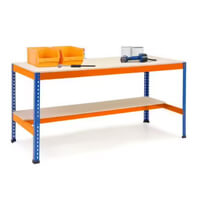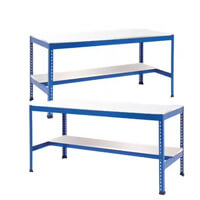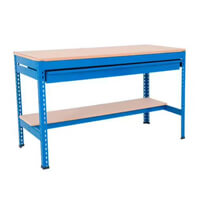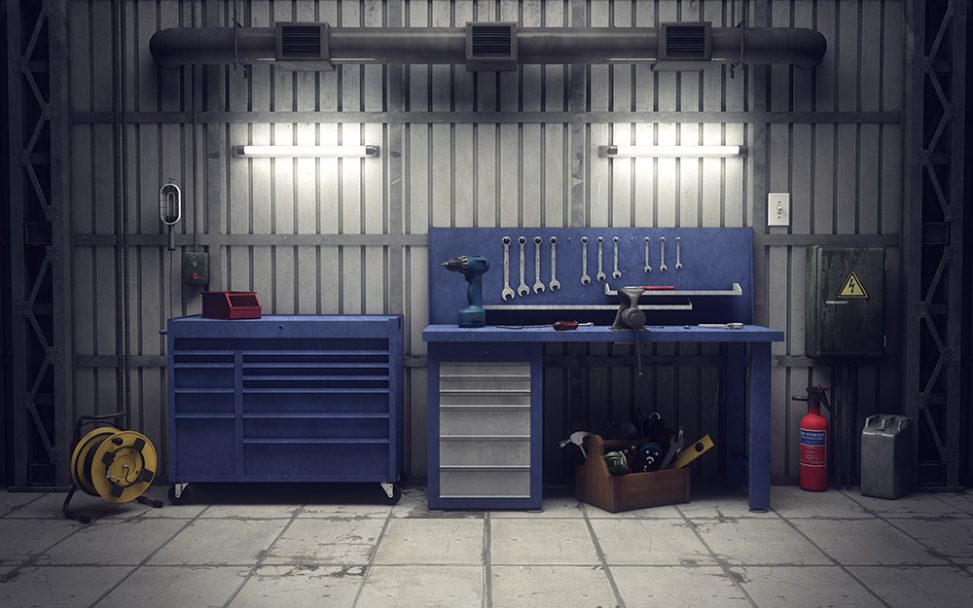For building or repairing items, workbenches and workstations are the safest way to use tools and equipment. Further accessories can be added to your workbench such as vices, drills and saws, while storage can also be built in to include drawers, cupboards and additional shelving below or above the workbench.
A traditional workbench would typically be built from solid wood, making it more comparable to a piece of furniture than an accessory within your garage or utility room. However, metal workbenches and workstations are becoming more popular due to how easy they are to build, enhance, dismantle and transport.
The process of creating a wooden workbench from timber isn’t as straightforward as simply buying a metal workbench. Wooden workbenches don’t come with instructions and you would need to source all the materials yourself, which can be expensive if you’re looking to make a solid timber workbench that should stand the test of time.
Choosing a metal workbench usually involves spending less money on parts and fewer hours on manufacturing. This option also gives you the ability to move or dismantle your workbench with complete ease in the future – an often underplayed advantage not enjoyed by traditional solid wood workbenches. In this useful guide, we look at metal workbench assembly, with a view to simplifying the construction of every range.
How to build a garage workbench
Although there are different options in terms of the type of workbench or workstation you’re choosing to build, most of them share the feature of not needing screws during assembly. Instead, each part is built to slot together, making it easy to build whilst maintaining sufficient strength and durability.
Instructions for building a metal garage workbench are as follows:
- Stand all four legs in a rectangular formation, fitting rubber feet to them to provide additional support.
- Align the long pieces of metal used for creating shelves with the legs of the workbench and push the metal prongs at the end of the long pieces into the holes in the legs.
- After checking that the pieces of metal are straight, hammer the prongs into place with a heavy-duty mallet.
- Repeat this process depending on the number of shelves you’re looking at having on your workbench.
- For every layer of the workbench, you have the option between a chipboard or a melamine surface, which will slot in between all four legs and sit above the long pieces of metal.
You could decide to fit a half shelf if you want extra space beneath the top of your workbench, or you could add additional shelving on top. Another consideration would be introducing a back panel which can be used for hanging tools, with the option of fitting a small table on top of the back panel to provide additional storage space.
How to fit a vice to a workbench
When building or repairing an item on your workbench, holding things in place can be made significantly easier with the use of a vice. These come in different shapes and sizes, but it is possible to attach them to your workbench in a variety of ways depending on the type of vice you choose.
Traditionally, vices have holes drilled in either side which house screws, making it easy to attach to a wooden workbench. However, when looking for the perfect vice for a metal workstation, it may be easier to find a vice that uses temporary clamps which attach to the top your workbench, or even a standalone vice that can be transported. This removes the often problematic step of having to drill into your metal workbench to install a new vice.
How to build drawers for a workbench
As a way of providing extra storage for people with a lot of tools and equipment, many workbenches and workstations come with additional drawers. Metal workstations usually come with a draw that can be built separately before being installed in the middle of the workstation. These are typically held up by small brackets in the legs.
It’s also possible to find workstation drawers which arrive preassembled, ready for attachment as soon as you’ve constructed your workstation to the desired height. However, there are many different types of workstations and workbenches, as well as a lot of different types of drawers for storage.
Both basic workbenches and heavy-duty workstations usually possess drawers, but you could also consider a compact workbench, a mobile workbench, a tool station or if you’re only looking at using your workstation for small repairs, a cupboard to provide a mass of storage options for your convenience.





Leave a Reply
You must be logged in to post a comment.